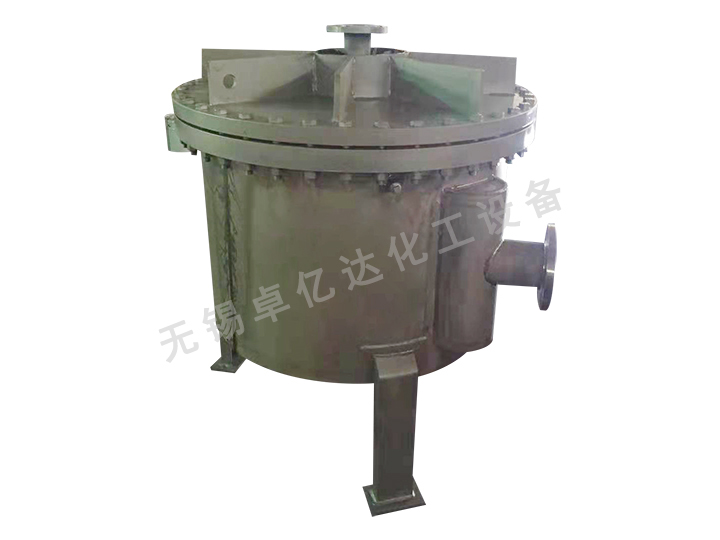Structural design
(1) Sealed structure
The quality of the sealing structure directly affects the normal operation of the spiral plate heat exchanger. Even if a small leak causes the two fluids to mix, the heat transfer cannot be performed normally, so the design of the sealing structure is a very important issue.
The sealing structure of the spiral plate heat exchanger has two forms, welding sealing and gasket end cover sealing.
1. Welding and sealing
There are three types of welding and sealing structure. One type of welding sealing structure is to pad the channel to be sealed into the steel plate with square steel, and then weld it after rolling. Another type of welding sealing structure is to roll the channel to be sealed with a round steel pad with the same width as the channel into a steel plate and then weld it. There is also a welding sealing structure in which the steel plate on one side of the channel is pressed into a bevel and then welded with the steel plate of the other channel.
2. Gasket end cap sealing
After the spiral plate is rolled, the two ends of the spiral channel are mechanically processed to achieve a certain smoothness, and then the spiral channel is sealed with a gasket with the same outer diameter as the sealing surface of the end cover. The gasket material is selected according to the characteristics and temperature of the medium; the bolt on the end cover is connected with the flange on the shell to meet the sealing requirements.
In order to ensure the sealing and compression of the gasket, when the end cap is in the form of a flat cap, due to the poor force of the flat cap, it will deflect after being compressed, which will easily cause a short circuit between the fluid channels, affect the heat transfer effect, and bring about adverse consequences. Therefore, flat caps are generally used for lower pressure occasions.
(2) Shell of spiral plate heat exchanger
The shell of the spiral plate heat exchanger is a component that bears internal pressure or external pressure. In order to improve the pressure bearing capacity of the shell, some manufacturers adopt the method of increasing the thickness of the outer spiral plate. But because the outer ring is still spiral, there is a longitudinal fillet weld. Since the strength of the fillet weld is not easy to guarantee and the force is poor, this structure cannot withstand higher pressure.
In order to improve the connection structure of the shell and the spiral plate and increase the pressure bearing capacity of the shell, the shell of the spiral plate heat exchanger is a cylinder formed by combining two semicircular rings and welding. The key part of this combination welding is the connecting plate. The connection method is to weld the spiral plate and the connecting plate first, and after passing the non-destructive flaw detection, welding the two semicircular shells with the connecting plate, and the welding structure adopts the butt weld with the liner plate. Butt welds are easy to ensure welding quality and have better bearing capacity, so this connection is firm and reliable, and fillet welds are avoided, thereby increasing the operating pressure of the spiral plate heat exchanger.
(3) The stiffness of the spiral plate
The spiral body is an elastic body. For such an elastic member, when it is compressed, it is often not crushed but collapsed, so the stiffness of the spiral plate is an important issue. In actual production, when the pressure difference between the two channels of the heat exchanger reaches a certain value, the spiral plate may be squashed and become unstable, making the equipment unable to operate normally. Increasing the rigidity of the spiral plate by increasing the plate thickness is not a good way to solve the problem. The increase of the plate thickness increases the power required by the coiled spiral body, which is uneconomical. Therefore, it is now commonly used to install distance columns in the two channels and reduce the distance between the distance columns (or distance bubbles), and increase the number of distance columns (or distance bubbles) to improve the rigidity and stiffness of the spiral plate. Pressure-bearing capacity, the fixed-distance column (or fixed-distance bubble) not only increases the stiffness of the spiral plate, but also plays a role in maintaining the width of the channel.
(4) Arrangement of inlet and outlet pipes
For non-detachable spiral plate heat exchangers, a central tube is generally arranged in a cross section perpendicular to the cylinder, and there are two arrangements for the connection of the spiral channel. One is that the connection is perpendicular to the axis of the cylinder. This kind of nozzle suddenly turns 90° when the fluid enters the spiral channel. According to fluid mechanics, when there is a sudden change in the direction of fluid flow, the resistance is greater. Another type of takeover is arranged tangentially. This arrangement will gradually flow in when the fluid enters the channel from the nozzle, and there is no sudden change in the flow direction, so the resistance is small, and it is easy to remove impurities from the equipment, but the processing is more difficult than the vertical nozzle. The above two arrangements for the takeover have their own advantages and disadvantages, and they are selected according to specific conditions during design. For detachable spiral plate heat exchangers, it should be determined according to specific requirements.
Technical parameter
|
Nominal heat transfer area |
Channel spacing |
Carbon steel |
Stainless steel |
|
Board thickness |
|
5m2 |
6—10 |
4mm |
2~3mm |
|
10m2 |
6—10 |
4mm |
2~3mm |
|
20m2 |
6—14 |
4mm |
2~3mm |
|
30m2 |
10—14 |
4mm |
2~3mm |
|
40m2 |
10—14 |
4mm |
2~3mm |
|
50m2 |
10—14 |
4mm |
2~3mm |
|
60m2 |
14—18 |
4mm |
2~3mm |
|
70m2 |
14—18 |
4mm |
2~3mm |
|
80m2 |
14—18 |
4mm |
2~3mm |
|
100m2 |
14—18 |
4mm |
2~3mm |
|
120m2 |
14—20 |
4~5mm |
2~4mm |
|
130m2 |
14—20 |
4~5mm |
2~4mm |
|
150m2 |
14—20 |
4~5mm |
2~4mm |
|
300m2 |
14—20 |
4~5mm |
2~4mm |

